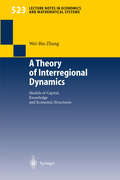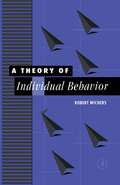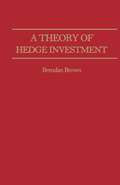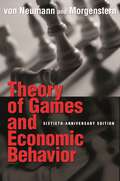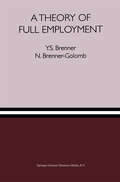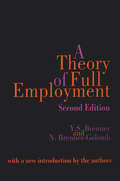- Table View
- List View
A Theory of Interregional Dynamics: Models of Capital, Knowledge and Economic Structures (Lecture Notes in Economics and Mathematical Systems #523)
by Wei-Bin ZhangOver more than two centuries the development of economic theory has created a wide array of different theories, concepts and results. Nevertheless, there is no general theory, which mrifies these varied theories into a comprehensive one. Economics has been split between partial and conflicting representations of the functioning of market economies. We have a collection of separate theories such as the Marxian economics, the Keynesian economics, the general equilibrium theory, and the neoclassical growth theory. These diverse economic theories have co-existed but not in a structured relationship with each other. Economic students are trained to understand economic phenomena by severally incompatible theories one by one in the same course. Since the end of Second Wodd War many crises in economic theory have been announced. The economist experienced the crisis of the general equilibrium economics, the crisis of the neoclassical growth economics, the crisis of the Keynesian economics, not to mention the crises of the Marxian economics. It is quite reasonable to expect the loss of confidence in theoretical economics even among professional economists after so many crises in a very short period of time. But a crisis offers new opportmrities for change, either for better or for worse. The past crises in theoretical economics may be perceived as a historical opportmrity to construct a general economic theory by which the traditional theories are integrated into a higher whole.
A Theory of International Trade Under Uncertainty
by Elhanan Helpman Assaf RazinA Theory of International Trade Under Uncertainty analyzes international trade in goods and securities in the presence of uncertainty using an integrated general equilibrium framework that recognizes the dependence of markets for goods on financial markets and vice versa. The usefulness of this approach is demonstrated by means of applications to questions such as the effects of international trade on resource allocation, tariff policy, and intervention in financial capital markets. Results which are important for theoretical as well as policy oriented applications are presented. Comprised of 11 chapters, this volume begins with an introduction to some of the fundamental elements of the deterministic Ricardian and Heckscher-Ohlin theories of international trade. Relevant elements from the theory of decision making under uncertainty are then discussed, along with the behavior of firms and consumers-investors in an economy with stock markets. Subsequent chapters focus on problems of commercial policy; gains from trade in goods and securities; and issues of intervention in financial capital markets. The book concludes by describing a dynamic model of international trade that contains an infinite horizon and takes into account the trade-off between present period consumption and savings. An example that illustrates an equilibrium structure of the dynamic model is presented.This monograph is intended for economists who are interested in international trade or international finance, including graduate students who specialize in these fields.
The Theory of International Trade: An Alternative Approach
by B. HorvatIn a previous book The Theory of Value, Capital and Interest , the systemic theory of value was developed for a closed economy. Now the economy is opened and the same theory is applied to international trade. Both books are intended to provide an alternative theoretical paradigm.
A Theory of International Trade: Capital, Knowledge, and Economic Structures (Lecture Notes in Economics and Mathematical Systems #482)
by Wei-Bin ZhangOver more than two centuries the development ofeconomic theory has created a wide array of different concepts, theories, and insights. My recent book Capital and Knowledge (Zhang, 1999a) shows how separate economic theories such as the Marxian economics, the Keynesian economics, the general equilibrium theory, and the neoclassical growth theory can be examined within a single theoretical framework. The Capital and Knowledge constructs an economic theory to account for the phenomena explained by the main economic theories (of national economies) in a unified manner. It tries to draw together the disparate branches of economics into a single organized system ofknowledge. This book is a part of my economic theory with endogenous population, capital, knowledge, preferences, sexual division of labor and consumption, institutions, economic structures and exchange values over time and space (Zhang, 1996a). As an extension of the Capital and Knowledge, which is focused on the dynamics of national economies, this book is to construct a theory of international trade. We are concerned with dynamic relations between international division of labor, division of consumption and determination of prices structure in global economy. We examine dynamic interdependence between capital accumulation, knowledge creation and utilization, economic growth, price structures and international trade patterns under free competition. Our theory is constructed on the basis of a few concepts within a compact framework.
The Theory of International Business: Economic Models and Methods
by Mark CassonDemonstrating why economic modelling is so important in understanding international business, this stimulating and highly original book sets out a new and exciting research agenda in international business studies. The author explains what economic models are, how they are constructed and the way in which they can be used. It illustrates how models clarify important issues in international business – explaining empirical anomalies, analyzing strategies and evaluating government policies towards multinational firms. There are detailed discussions of monopoly and competition in the global economy; the international division of labour; supply chain coordination; and the strategic implications of sunk costs in R&D. Based on this discussion, the book proposes a radical reformulation of the theory of the firm as applied to international business.
The Theory of Interest
by Friedrich LutzThis book contains a critical analysis of the main theories of interest which have been published since B÷hm-Bawerk. The last part of the book gives an account of the author's own theory.The first part, which deals with the history of doctrines, discusses the theories of B÷hm-Bawerk, Wicksell, Akerman, and Hayek, authors who proceed from the assumption of stationary state.The second group of authors consists of Walras, Irving Fisher, and F. H. Knight, who assume a progressive economy in which net saving and investment occur.The third group of authors are those who stress the monetary factor. The central figure of this part is Keynes; but other authors, among them Patinkin, are also dealt with. The theories on the term structure of interest rates are discussed in the last part of the history of doctrines. The author's own theory deals with the problem of the interest rate first in terms of partial equilibrium analysis, whereby particular attention is paid to the influence of the banking system on the structure of interest rates.In the final chapter the author proceeds to expound the interest theory in the framework of general equilibrium analysis. A mathematical appendix concludes this book.Friedrich A. Lutz (1901-1975) taught economics at Princeton University for fifteen years before becoming Professor of Economics at the University of Zurich. He was also the president of the Mont Pelerin Society from 1964-1967.
The Theory of Interest
by Friedrich LutzThis book contains a critical analysis of the main theories of interest which have been published since B÷hm-Bawerk. The last part of the book gives an account of the author's own theory.The first part, which deals with the history of doctrines, discusses the theories of B÷hm-Bawerk, Wicksell, Akerman, and Hayek, authors who proceed from the assumption of stationary state.The second group of authors consists of Walras, Irving Fisher, and F. H. Knight, who assume a progressive economy in which net saving and investment occur.The third group of authors are those who stress the monetary factor. The central figure of this part is Keynes; but other authors, among them Patinkin, are also dealt with. The theories on the term structure of interest rates are discussed in the last part of the history of doctrines. The author's own theory deals with the problem of the interest rate first in terms of partial equilibrium analysis, whereby particular attention is paid to the influence of the banking system on the structure of interest rates.In the final chapter the author proceeds to expound the interest theory in the framework of general equilibrium analysis. A mathematical appendix concludes this book.Friedrich A. Lutz (1901-1975) taught economics at Princeton University for fifteen years before becoming Professor of Economics at the University of Zurich. He was also the president of the Mont Pelerin Society from 1964-1967.
A Theory of Insurance and Gambling: Replacing Risk Preferences with Quid pro Quo
by John A. NymanIn 1948, Milton Friedman and L. J. Savage suggested that risk preferences explain the demand for insurance and gambling--a theory that is still almost universally accepted by economists today. If you were to ask almost any economist why people purchase insurance, they would say it is because most people are "risk averse," or equivalently, "prefer certainty of losses." If asked to explain why people gamble, they would say it is because some people are "risk seekers." In A Theory of Insurance and Gambling, John A. Nyman critiques this approach and proposes a new theory of the motivations for insurance and gambling. He argues that demand for insurance and gambling is best understood by focusing not on risk preferences, but on the income transfer, the states of the world that trigger the income transfer, and the value of the income in those states. In other words, insurance is motivated by a preference to transfer income to future states of the world where income is more valuable. Gambling, on the other hand, is motivated by a preference to transfer income to future states of the world where additional income is less costly to obtain. Nyman ultimately seeks to reorient how economists think about insurance and gambling by moving away from seeing uncertainty as a negative motivating factor to simply a mechanical feature that allows for the augmentation of income and consumption. He moves away from biased models that ignore income effects and state dependency when evaluating the benefits from insurance and gambling, and away from preferences regarding risk toward the desire to obtain additional future income. Presenting the case that risk preferences do not motivate demand for insurance or gambling, A Theory of Insurance and Gambling calls into question a fundamental tenet of economic thinking.
A Theory of Insurance and Gambling: Replacing Risk Preferences with Quid pro Quo
by John A. NymanIn 1948, Milton Friedman and L. J. Savage suggested that risk preferences explain the demand for insurance and gambling--a theory that is still almost universally accepted by economists today. If you were to ask almost any economist why people purchase insurance, they would say it is because most people are "risk averse," or equivalently, "prefer certainty of losses." If asked to explain why people gamble, they would say it is because some people are "risk seekers." In A Theory of Insurance and Gambling, John A. Nyman critiques this approach and proposes a new theory of the motivations for insurance and gambling. He argues that demand for insurance and gambling is best understood by focusing not on risk preferences, but on the income transfer, the states of the world that trigger the income transfer, and the value of the income in those states. In other words, insurance is motivated by a preference to transfer income to future states of the world where income is more valuable. Gambling, on the other hand, is motivated by a preference to transfer income to future states of the world where additional income is less costly to obtain. Nyman ultimately seeks to reorient how economists think about insurance and gambling by moving away from seeing uncertainty as a negative motivating factor to simply a mechanical feature that allows for the augmentation of income and consumption. He moves away from biased models that ignore income effects and state dependency when evaluating the benefits from insurance and gambling, and away from preferences regarding risk toward the desire to obtain additional future income. Presenting the case that risk preferences do not motivate demand for insurance or gambling, A Theory of Insurance and Gambling calls into question a fundamental tenet of economic thinking.
Theory of Innovation: A New Paradigm of Growth
by Jati SenguptaThe current economic theory of innovation mainly analyses the technology factor and its impact on economic growth. In today's world, growth in information technology and knowledge of new ideas has altered the business paradigm dramatically. Modern economies have undergone a dynamic shift from material manufacturing to a new information technology model with research and development (R&D) and human capital. Through information and communications technology efficient information usage has achieved substantial productivity gains through learning by doing and incremental innovations. The present volume discusses this new paradigm in terms of both theory and industry applications, including Schumpeter in his innovation model and the emphasis on new innovations replacing the old. Growth of business networking and R&D consortium have dramatically helped the modern business to reduce their unit costs and improve efficiency. This volume presents some new models emphasizing knowledge sharing and R&D cooperation. Rapid growth in recent times in some south Asian countries have been cited as growth miracles are largely caused by knowledge spillover and learning by doing, and this volume also investigates the role of incremental innovations. With a strong focus and extension of the current theory of innovation and industry growth experiences of both the US and Asian countries, this book will be of interest to MBA and graduate students in economics, innovation management, and applied industrial economics.
A Theory of Individual Behavior
by Robert WichersA Theory of Individual Behavior dispels the notion that individuals act as rational agents and strives to capture idiosyncratic humanness through rigorous mathematics. Wichers describes a version of economic behavior that is more comprehensive and satisfying than neoclassical models yet still consistent with the usual aggregated concepts that form the basis of applied microeconomics. Written in an accessible and convincing style, A Theory of Individual Behavior discusses innovative material in a format that encourages classroom use. All chapters have questions at their conclusions, and there is a strong emphasis on testable results. The book contains a short review of mathematical models and discussion of received microeconomic theory, as well as summaries at the ends of chapters and many examples and illustrations.Dispels the notion that individuals act as rational agents while capturing idiosyncratic human behavior through rigorous mathematicsPresents an innovative approach to the evolution of microeconomic theoryPromotes advances in behavioral theories in the social sciences, including psychology and sociologyDelivers an accessible style with a strong emphasis on testable results
The Theory of Incentives: The Principal-Agent Model
by Jean-Jacques Laffont David MartimortEconomics has much to do with incentives--not least, incentives to work hard, to produce quality products, to study, to invest, and to save. Although Adam Smith amply confirmed this more than two hundred years ago in his analysis of sharecropping contracts, only in recent decades has a theory begun to emerge to place the topic at the heart of economic thinking. In this book, Jean-Jacques Laffont and David Martimort present the most thorough yet accessible introduction to incentives theory to date. Central to this theory is a simple question as pivotal to modern-day management as it is to economics research: What makes people act in a particular way in an economic or business situation? In seeking an answer, the authors provide the methodological tools to design institutions that can ensure good incentives for economic agents. This book focuses on the principal-agent model, the "simple" situation where a principal, or company, delegates a task to a single agent through a contract--the essence of management and contract theory. How does the owner or manager of a firm align the objectives of its various members to maximize profits? Following a brief historical overview showing how the problem of incentives has come to the fore in the past two centuries, the authors devote the bulk of their work to exploring principal-agent models and various extensions thereof in light of three types of information problems: adverse selection, moral hazard, and non-verifiability. Offering an unprecedented look at a subject vital to industrial organization, labor economics, and behavioral economics, this book is set to become the definitive resource for students, researchers, and others who might find themselves pondering what contracts, and the incentives they embody, are really all about.
The Theory of Implementation of Socially Optimal Decisions in Economics
by L. CorchonSince the early seventies, following the pioneering work by Leo Hurwicz, economists have been studying the relationship between socially optimal goals and private self-interest. The task was to reconcile the Utopian and Hobbesian traditions, using game theory to find ways to organise the society that are both socially optimal and incentive compatible. This book provides a succinct and up-to-date account of this vast literature and will be welcomed by students, lecturers and anyone wishing to update their knowledge of the field.
A Theory of Housing Provision under Capitalism (Marx, Engels, and Marxisms)
by Mike BerryThis book provides the first coherent Marxist analysis of the central importance of housing in the social reproduction of capitalism as a whole. Rather than consigning housing to the sidelines, Berry argues that the circulation of capital and revenues though housing and the built environment helps explain how the capital-labour relation constrains housing outcomes while also being reproduced on an extended scale. He shows how housing is provided by the intervention of building, property and interest-bearing capital fractions; how the land question can be explained by a theory of urban land rent, drawing on Marx's categories of differential and monopoly rent; how housing is vital to the extended reproduction of labour power, while also creating a semi-separate sphere of 'home' in which gender and demographic factors overlay and accentuate social class position. The modes, impact and drivers of state intervention in housing provision are seen to modify the patterns and pace of capital circulation through housing and the urban built environment with implications for shifts in class fragmentation and power relations.
The Theory of Hospitality and Catering, 14th Edition
by Professor David Foskett Patricia Paskins Andrew Pennington Neil RippingtonPrepare students for assessment and further professional development with a wealth of contemporary case studies from around the world, referencing key trends.· Discover how to integrate sustainability and environmental improvements into kitchens and eating spaces, helping to increase energy conservation and boost your green credentials. · Harness the power social media and e-marketing to proactively grow your business, online visibility and engagement.· Ensure best practice is followed where food allergies and intolerances are concerned, so you can be confident you are providing a safe experience for all customers.· Develop your understanding of nutrition and culinary medicine with a unique contribution from Elaine Macaninch, a director of Culinary Medicine UK and the co-founder of the Education and Research in Medical Nutrition Network (ERimNN)· Plan for commercial success with clear coverage of financial aspects of food and beverage management, personal development and people management skills.
A Theory of Heuristic Information in Game-Tree Search (Symbolic Computation)
by Chun-Hung TzengSearching is an important process in most AI systems, especially in those AI production systems consisting of a global database, a set of production rules, and a control system. Because of the intractability of uninformed search procedures, the use of heuristic information is necessary in most searching processes of AI systems. This important concept of heuristic informatioD is the central topic of this book. We first use the 8-puzzle and the game tic-tac-toe (noughts and crosses) as examples to help our discussion. The 8-puzzle consists of eight numbered movable tiles set in a 3 x 3 frame. One cell of the frame is empty so that it is possible to move an adjacent numbered tile into the empty cell. Given two tile configurations, initial and goal, an 8-puzzle problem consists of changing the initial configuration into the goal configuration, as illustrated in Fig. 1.1. A solution to this problem is a sequence of moves leading from the initial configuration to the goal configuration, and an optimal solution is a solution having the smallest number of moves. Not all problems have solutions; for example, in Fig. 1.1, Problem 1 has many solutions while Problem 2 has no solution at all.
The Theory of Guanxi and Chinese Society
by Jack BarbaletThe concept of guanxi is used extensively in Chinese society. Loosely understood as 'connections' or 'networks', it refers to long-term mutually reinforcing exchanges between individuals based on affective and normative commitments. This book comprehensively examines the nature and background of this extremely significant and distinct feature of Chinese social, political, economic, and business relations. It takes account of the major theoretical frameworks that relate to the long-term connections that are developed to pursue instrumental advantage in a society marked by relatively weak legal and regulatory institutions. The book locates such theorizing in the major features of the rapidly evolving Chinese market society. Yet it also pays attention to the historical origins and cultural sources of a highly particularistic approach to the acquisition of social and material resources — an approach which relies on obligatory relations of favour exchange between persons who self-consciously and strategically select their associates and goals. This sociological treatment of guanxi challenges many dominant conventions and introduces a novel research approach which captures the pertinent psychological dispositions, cultural expressions, and institutional frameworks that underpin the phenomenon.
The Theory of Guanxi and Chinese Society
by Jack BarbaletThe concept of guanxi is used extensively in Chinese society. Loosely understood as 'connections' or 'networks', it refers to long-term mutually reinforcing exchanges between individuals based on affective and normative commitments. This book comprehensively examines the nature and background of this extremely significant and distinct feature of Chinese social, political, economic, and business relations. It takes account of the major theoretical frameworks that relate to the long-term connections that are developed to pursue instrumental advantage in a society marked by relatively weak legal and regulatory institutions. The book locates such theorizing in the major features of the rapidly evolving Chinese market society. Yet it also pays attention to the historical origins and cultural sources of a highly particularistic approach to the acquisition of social and material resources — an approach which relies on obligatory relations of favour exchange between persons who self-consciously and strategically select their associates and goals. This sociological treatment of guanxi challenges many dominant conventions and introduces a novel research approach which captures the pertinent psychological dispositions, cultural expressions, and institutional frameworks that underpin the phenomenon.
Theory of General Economic Equilibrium
by Trout RaderTheory of General Economic Equilibrium provides information pertinent to the general economic equilibrium theory. This book covers a variety of topics, including efficiency, economic systems analysis, welfare economics, and international trade.Organized into three parts encompassing eight chapters, this book begins with an overview of the theory of efficient production and growth where consumer preferences play a subordinate role. This text then examines that for the case where preferences satisfy appropriate conditions, efficiency theory is superseded as normative analysis by optimality theory. Other chapters consider the optimization of consumer preferences that leads to the decline of many families. This book discusses as well the existence of equilibrium, which is of importance to both normative and positive economics. The final chapter deals with the question of the speed with which the economic system attains its equilibrium state, which is assumed to be stationary.This book is a valuable resource for professional economists and advanced graduate students in economics.
Theory of Games and Economic Behavior
by John Von Neumann Oskar Morgenstern Harold William Kuhn Ariel RubinsteinThis is the classic work upon which modern-day game theory is based. What began more than sixty years ago as a modest proposal that a mathematician and an economist write a short paper together blossomed, in 1944, when Princeton University Press published Theory of Games and Economic Behavior. In it, John von Neumann and Oskar Morgenstern conceived a groundbreaking mathematical theory of economic and social organization, based on a theory of games of strategy. Not only would this revolutionize economics, but the entirely new field of scientific inquiry it yielded--game theory--has since been widely used to analyze a host of real-world phenomena from arms races to optimal policy choices of presidential candidates, from vaccination policy to major league baseball salary negotiations. And it is today established throughout both the social sciences and a wide range of other sciences. This sixtieth anniversary edition includes not only the original text but also an introduction by Harold Kuhn, an afterword by Ariel Rubinstein, and reviews and articles on the book that appeared at the time of its original publication in the New York Times, tthe American Economic Review, and a variety of other publications. Together, these writings provide readers a matchless opportunity to more fully appreciate a work whose influence will yet resound for generations to come.
Theory of Games and Economic Behavior
by John Von Neumann Oskar Morgenstern Harold William Kuhn Ariel RubinsteinThis is the classic work upon which modern-day game theory is based. What began more than sixty years ago as a modest proposal that a mathematician and an economist write a short paper together blossomed, in 1944, when Princeton University Press published Theory of Games and Economic Behavior. In it, John von Neumann and Oskar Morgenstern conceived a groundbreaking mathematical theory of economic and social organization, based on a theory of games of strategy. Not only would this revolutionize economics, but the entirely new field of scientific inquiry it yielded--game theory--has since been widely used to analyze a host of real-world phenomena from arms races to optimal policy choices of presidential candidates, from vaccination policy to major league baseball salary negotiations. And it is today established throughout both the social sciences and a wide range of other sciences. This sixtieth anniversary edition includes not only the original text but also an introduction by Harold Kuhn, an afterword by Ariel Rubinstein, and reviews and articles on the book that appeared at the time of its original publication in the New York Times, tthe American Economic Review, and a variety of other publications. Together, these writings provide readers a matchless opportunity to more fully appreciate a work whose influence will yet resound for generations to come.
A Theory of Full Employment
by Y.S. Brenner N. Brenner-GolombThis book has three purposes. First, to convince professional economists who study the behaviour of the economic system as a whole that they must re-examine some of the assumptions behind the reigning economic theories. Second, to explain to the general public why the currently fashionable economic policies cannot solve the problem of massive long term unemployment. Third, to show that if people's political engagement is revived there is hope for escaping from the economic morass and moral wasteland into which, ever since the 1970s, the fashionable policies have been leading us. To elucidate the theoretical problem the authors pass in review several recent structural developments and consider their effect on the economy. To encourage renewed public political engagement they draw attention to the risks involved in allowing things to drift on in the present direction. The avowed purpose of the book imposes the need to present it in a manner accessible at once to professional macroeconomists and to a wider public ofpeople concerned about today's malaise, politicians, sociologists or philosophers and others. This imposes the need not to encumber readers with the customary glut of academic references in the text, and to refer only to the best known and politically most influential theories and to authors who are also widely known to people who are not professional economists.
A Theory of Full Employment
by Nancy Brenner-GolombIn A Theory of Full Employment, Y. S. Brenner reviews the current drift toward a society he finds neither economically expedient nor morally attractive, and N. Brenner-Golomb discusses the risks involved for science and society in the newfangled sophism hiding behind post-modern ideas and "political correctness." Both authors emphasize the need to revive the public's political engagement and revise economic theory to restore to society the humane perspective that inspired the welfare state. They contend that if people will abandon outworn habits of thought, consider alternatives, and renew their political engagement, they may find useful employment for all who are able and willing to work and end the fear of destitution. Although scientists' philosophical backgrounds seldom influence their answers, they do determine their questions, and the final outcome can depend on this. Neoclassical economists are ill equipped to ask questions about the long-term dynamic processes of our complex economic reality. They leave out of their models variables not easily quantified and prefer mathematical precision to the study of the intricacy of life. Paul Samuelson, Robert Solow, and others have tried to overcome this by grouping self-adjusting elements into "proxy" variables, thus synthesizing neoclassical and Keynesian ideas. But most of today's critics of the ruling dogma go largely unheard. This volume is intended to convince professional economists who study the economic system as a whole to reexamine some of the assumptions behind reigning economic theories. A second objective is to explain to the general public why currently fashionable policies cannot solve massive long-term unemployment. Finally, it shows that if political engagement is revived, we may escape the economic morass and moral wasteland into which, the fashionable policies have been leading us since the 1970s. This book will appeal to economists, politicians, sociologists, and a wider public concerned about today's economic malaise.
